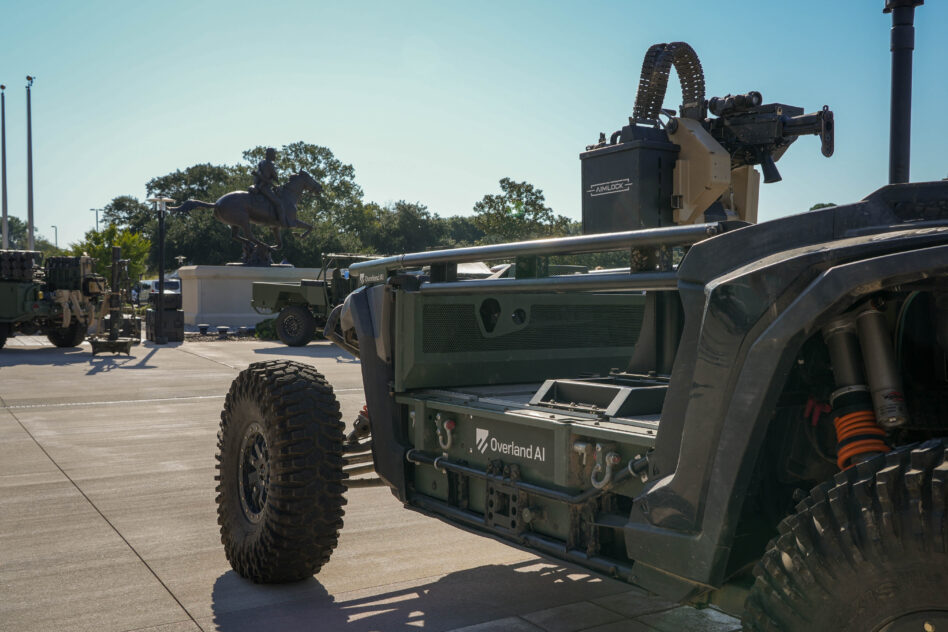Thought we were done with the partnership news? Think again. This morning, autonomous targeting company AimLock announced that it’s teamed up with ground autonomy startup Overland AI to build its “autonomous targeting and engagement systems” (read: hands-free pew-pew) onto Overland’s ULTRA unmanned vehicle.
Sounds like a certain drone-car is getting a lethal glow-up.
Big brain: Let’s kick things off with AimLock, because they’re new around here. The Colorado-based company was founded in 2013 and, put simply, makes everyday weapons like machine guns and turrets target and “engage” (go boom) autonomously.
Their flagship product is called Keystone, a “Core Targeting Module” that “combines sensor management, computer vision, artificial intelligence, networks, and sensor fusion with advanced fire control, target tracking, and platform management to create speed and accuracy never achieved before with individual, remote, and unmanned weapon systems.” Phew.
Put simply: think of the module—a small little black cube—as the super-smart brain that takes small arms and makes them (at least partially) autonomous.
Keystone powers a whole range of kit that takes weapons and makes them unmanned:
- Rampart (R-M1): A semi-autonomous remote weapon station for medium machine gun platforms.
- Highline (I-M1): A lightweight, stabilized, auto-targeting chassis designed for use with existing medium range rifles.
- Switchback (R-S1): A miniature stabilized remote system for weapons weighing between 15 and 25 pounds.
- Summit (R-S4): A long-range targeting package for weapon systems weighing between 25 and 35 pounds.
- Divide (R-S2): Automated target acquisition and firing solutions for weapon systems weighing between 45 and 65 pounds.
- Caprock: A single-tube launcher integration for guided rockets/missiles that can be built onto unmanned platforms.
All of this is designed to keep humans away from weapons (and positions) that can put them at risk. However, AimLock CEO Bryan Bockmon emphasized to Tectonic that humans are still very much in the loop with all of these targeting and engagement systems.
“When designing systems built on a human-in-the-loop model, our priority is ensuring that combatant commanders retain final authority over engagement decisions,” he said, “Even in contested or communications-denied environments, our technology preserves human oversight.”
The company has already teamed up with other defense companies to build these systems into unmanned ground systems, including Ghost Robotics’ V60 and Teledyne FLIR Defense’s ground robots. In other words, this isn’t AimLock’s first rodeo.
On the ground: We’ve covered Overland AI a few times before, so we’ll keep it brief: The company was founded in Seattle in 2022 by Byron Boots (CEO), Stephanie Bonk (President), Greg Okopal (COO) and builds full-stack autonomy for ground vehicles.
The company has built its own UGV (called ULTRA), as well as an “uplift kit” called SPARK that can take pretty much any vehicle and make it autonomous. All of the company’s tech runs on an autonomy stack called “OverDrive” that’s built for off-road, map-free environments.
And they’ve had some major wins:
- Earlier this year, the company closed a $32M Series A led by 8VC.
- In August, Overland was tapped by the Army to prototype an autonomous Infantry Squad Vehicle (ISV).
- They’ve also worked with DIU on the RCV program and tested kit with the Marines and the Army.
AimLock isn’t their first defense tech mash-up, either: The company has teamed up with L3Harris to build a Diamondback AGV, among a slew of other partnerships.
Plug it in: At AUSA next week, Overland’s ULTRA vehicle will be shown with AimLock’s Rampart machine gun tower, but Bockmon says they’re not stopping there. “Any of our weapon systems that meet the weight specifications of the ULTRA can be selected,” he said. However, he remained coy over whether AimLock plans to be part of Overland’s ISV (or other) designs for the DoD.
“AimLock is certainly happy to compete for an opportunity in this program or any other programs,” he said, “Really our goal is that we will always continue working to create the best outcomes possible for the warfighter.”

